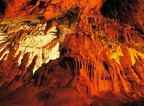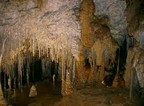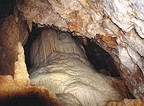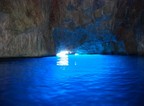Adapted to the natural environment for millions of years, most Greek caves are waiting with eternal patience to be explored. Greece is ranked first worldwide for its number of caves, which is largely due to the intense seismic activity. They are characterized according to their location and form
The creation of a cave is mostly the result of a painstaking work of nature that lasts several million years. The underground waters of the earth contain acids that erode the limestone creating cavities. Formations that are created later as stalactites or stalagmites are limestone deposits on the walls of the cave. Besides their scientific interest, the caves carry a mysterious attraction for visitors who are moving between superstition and tragic romance. All known Greek caves surround their name with legends of ghosts and forgotten love. The names given to the chambers and formations if anything, suggest a strong imagination.
The first people of the earth, even before the Paleolithic period, discovered that wild animals were using caves as shelter and decided to follow suit to get protected and breed. Over the years, the shelter has evolved into a dwelling. The cave of Petralona Halkidiki hosts the first Archanthropus of Europe with his tools, weapons and household items around. Other caverns as Loutraki Pella, exhibit finds from prehistoric animal bones. Several thousand years later, the caves were used as dens and retreats for orthodox monks and are preserved intact to this day, as the hermitages of Prespa. Places of worship in ancient mythology, modern temples pilgrimage to sample the most important cave of the Apocalypse on Patmos. Today they are not used as shelters, schools or hidden graves. People just enjoy their outstanding natural beauty.
Because no cave is the same as another, each one is accompanied by its own legends and does not create the same feelings, maybe it is better to visit all the caves you can, depending on where you find yourself in Greece:
- Thrace:
Rhodope Mountains, the Cave of the Cyclops, Maronia.
The cave of Maronia is the only place on our planet where rare species populations live.
Evros, Cave Makri.
According to mythology, the Cyclops Polyphemus lived there. It was actually inhabited or used by ancient tribes, judging from the findings of the pots.
- Macedonia:
Serres, Cave Alistrati.
The cave Alistrati is one of the largest caves in Europe and one of the most beautiful in Greece. The rich decoration includes, apart from huge stalactites and stalagmites in various colors and rare eccentrites.
Drama, Cave Maara, Prosotsani.
The roof of the cave is filled with stalactites, its length about 500 meters and the visitor’s interest focuses on the striking colors of the rocks.
Kilkis, Cave of St. George.
Its area exceeds 1,000 square meters. This two-storey cave except for the pleasure of exploration has healing properties for people with respiratory problems.
Halkidiki, Cave Petralona.
The fossilized skull found, dating from 600,000 BC and was attributed to Homo sapiens, the wise man of the Neolithic era.
Pella, Cave Baths of Loutraki.
In a complex of more than fifteen caves discovered stone tools, arrows that give valuable information and evidence that the area was inhabited since the Stone Age. Furthermore fossils of prehistoric animals were found.
- Epirus:
Ioannina, Perama Cave.
This is an amazing cave with a total area of approximately 15 square km and some special formations. In order to cross the cave it will take you about 45 minutes.
- Central Greece:
County Cave Peania.
The cave is divided into sections. Each one of these shows wonderful patterns that emerge even more because of the special lighting and attentive tour.
Achaia, Cave Lake, Kalavryta.
Unique cave that spans three floors which consist of thirteen lakes and amazing rock formations!
Laconia, Cave Diro.
Cave complex is composed of three individual caves Glyfada, shelters and Alepotrypa. The cave is a lake and you can explore it only by boat. The whole tour takes about 40 minutes. Do not miss the Neolithic Museum of Diro.
Crete:
Rethymno, Cave Sheet.
In terms of view and in its interior decoration, the cave is considered the finest in the country.
Rethymno, Cave Melidoni.
This is one of the caves that never ceased to be used. It was used as a shelter and as a place of worship during the Minoan times and even as a grave for the victims of war.
Lassithi Dikteon Cave.
According to mythology, Rhea gave birth here to Zeus to protect him from his father. The cave is divided into two floors and five sections. Downstairs there is a pool that reflects the beauty of stalactites.
- Ionian Islands:
Kefalonia, Drogarati Cave.
The light interacts with stalactites, creating a spectacular phenomenon. In the great hall of the cave, dimensioned 30 x 40 concerts and events are organized.
Kefalonia Melissani Cave.
The cave has a total length of 3.5 km. Because of its roof collapsed in some places, the sunlight that enters together with the reflections of the lake creates images of inconceivable beauty.
- Cyclades:
Antiparos, Antiparos Cave.
The most impressive part is the great hall of eight measures. In 1673 a Catholic priest celebrated Christmas here as evidenced by the inscription is carved in stone.
Patmos, Cave of the Apocalypse.
It is a smaller but a world-famous cave, where John wrote the Revelation of the Bible.
The caves are mentioned above provide tours and information. There are many others across the country, equally impressive. There are caves that hide inside them some Greek mythology. Caves visited by love to praise the noble human feeling. The truth is that you will not find an inch of land that leaves you indifferent to the charm of discovery.





